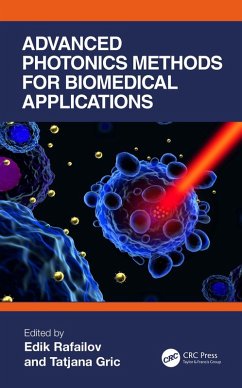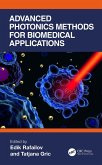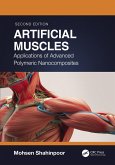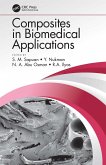Advanced Photonics Methods for Biomedical Applications (eBook, PDF)
Redaktion: Rafailov, Edik; Gric, Tatjana
50,95 €
50,95 €
inkl. MwSt.
Sofort per Download lieferbar

25 °P sammeln
50,95 €
Als Download kaufen

50,95 €
inkl. MwSt.
Sofort per Download lieferbar

25 °P sammeln
Jetzt verschenken
Alle Infos zum eBook verschenken
50,95 €
inkl. MwSt.
Sofort per Download lieferbar
Alle Infos zum eBook verschenken

25 °P sammeln
Advanced Photonics Methods for Biomedical Applications (eBook, PDF)
Redaktion: Rafailov, Edik; Gric, Tatjana
- Format: PDF
- Merkliste
- Auf die Merkliste
- Bewerten Bewerten
- Teilen
- Produkt teilen
- Produkterinnerung
- Produkterinnerung

Bitte loggen Sie sich zunächst in Ihr Kundenkonto ein oder registrieren Sie sich bei
bücher.de, um das eBook-Abo tolino select nutzen zu können.
Hier können Sie sich einloggen
Hier können Sie sich einloggen
Sie sind bereits eingeloggt. Klicken Sie auf 2. tolino select Abo, um fortzufahren.

Bitte loggen Sie sich zunächst in Ihr Kundenkonto ein oder registrieren Sie sich bei bücher.de, um das eBook-Abo tolino select nutzen zu können.
This book provides researchers and professionals in the area of biomedical photonics with a toolbox of novel methodologies for biomedical applications, including health diagnostics, cancer detection and treatment.
- Geräte: PC
- ohne Kopierschutz
- eBook Hilfe
- Größe: 24.22MB
Andere Kunden interessierten sich auch für
![Advanced Photonics Methods for Biomedical Applications (eBook, ePUB) Advanced Photonics Methods for Biomedical Applications (eBook, ePUB)]() Advanced Photonics Methods for Biomedical Applications (eBook, ePUB)50,95 €
Advanced Photonics Methods for Biomedical Applications (eBook, ePUB)50,95 €![Biomedical Photonics Handbook (eBook, PDF) Biomedical Photonics Handbook (eBook, PDF)]() Biomedical Photonics Handbook (eBook, PDF)62,95 €
Biomedical Photonics Handbook (eBook, PDF)62,95 €![Biomedical Applications of Magnetic Particles (eBook, PDF) Biomedical Applications of Magnetic Particles (eBook, PDF)]() Biomedical Applications of Magnetic Particles (eBook, PDF)78,95 €
Biomedical Applications of Magnetic Particles (eBook, PDF)78,95 €![Super-Resolution Imaging in Biomedicine (eBook, PDF) Super-Resolution Imaging in Biomedicine (eBook, PDF)]() Super-Resolution Imaging in Biomedicine (eBook, PDF)40,95 €
Super-Resolution Imaging in Biomedicine (eBook, PDF)40,95 €![Computer-aided Design and Diagnosis Methods for Biomedical Applications (eBook, PDF) Computer-aided Design and Diagnosis Methods for Biomedical Applications (eBook, PDF)]() Computer-aided Design and Diagnosis Methods for Biomedical Applications (eBook, PDF)50,95 €
Computer-aided Design and Diagnosis Methods for Biomedical Applications (eBook, PDF)50,95 €![Artificial Muscles (eBook, PDF) Artificial Muscles (eBook, PDF)]() Mohsen ShahinpoorArtificial Muscles (eBook, PDF)46,95 €
Mohsen ShahinpoorArtificial Muscles (eBook, PDF)46,95 €![Composites in Biomedical Applications (eBook, PDF) Composites in Biomedical Applications (eBook, PDF)]() Composites in Biomedical Applications (eBook, PDF)151,95 €
Composites in Biomedical Applications (eBook, PDF)151,95 €-
-
-
This book provides researchers and professionals in the area of biomedical photonics with a toolbox of novel methodologies for biomedical applications, including health diagnostics, cancer detection and treatment.
Dieser Download kann aus rechtlichen Gründen nur mit Rechnungsadresse in A, B, BG, CY, CZ, D, DK, EW, E, FIN, F, GR, HR, H, IRL, I, LT, L, LR, M, NL, PL, P, R, S, SLO, SK ausgeliefert werden.
Produktdetails
- Produktdetails
- Verlag: Taylor & Francis
- Seitenzahl: 226
- Erscheinungstermin: 31. Juli 2023
- Englisch
- ISBN-13: 9781000880052
- Artikelnr.: 68301501
- Verlag: Taylor & Francis
- Seitenzahl: 226
- Erscheinungstermin: 31. Juli 2023
- Englisch
- ISBN-13: 9781000880052
- Artikelnr.: 68301501
Edik Rafailov received the PhD degree from the Ioffe Institute in 1992. In 1997 he moved to St Andrews University (UK) and in 2005 he established a new group at Dundee University. In 2014 he and his Optoelectronics and Biomedical Photonics Group moved to Aston University (UK). He has authored and co-authored over 450 articles in refereed journals and conference proceedings, including two books, ten invited chapters, and numerous invited talks. He coordinated the EUR14.7M FP7 FAST-DOT project development of new ultrafast lasers for biophotonics applications and the EUR12.5M NEWLED project, which aims to develop a new generation of white LEDs. He coordinates the H2020 FET Mesa-Brain (which aims to develop 3D nano-printing technology for functional three-dimensional human stem cell-derived neural networks), NEUROPA (which aims to develop novel non-invasive theragnostic approaches), the H2020 PLATFORMA project, and the EPSRC (EP/R024898/1 proposal. He also leads a few other projects funded by the EU and EPSRC (UK). His current research interests include high-power CW and ultrashort-pulse lasers; generation of UV/visible/IR/MIR and THz radiation nanostructures; nonlinear and integrated optics; and biomedical photonics. Tatjana Gric's research career has been focused on the investigation of waveguide devices (waveguide modulators, filters etc.), namely on proposing their electrodynamical analysis. Applied research includes the design of microwave frequency selective structures, waveguide modulators, and filters. Fundamental research is primarily concerned with developing rigorous computational methods for the electrodynamical analysis of the waveguide structures. Another major goal of her studies is plasmonics as the examination of the interaction between electromagnetic field and free electrons in a metal. The optically active nanostructures have been simulated and their fundamental photonic properties have been explored. Moreover, the broad scope of research carried out by Dr. Gric has included investigations into the new fascinating properties of novel materials. Dr. Gric is involved in development of unusual materials and structures that can manipulate the flow of light in ways that are useful in optical sensing, photovoltaics, solid-state lighting, fiber optics, and other applications. Dr. Gric has published extensively in her field of investigation with more than 50 peer-reviewed papers in top journals in physics, electrodynamics, and optics and has written one book and two book chapters. It is worth noting that her recent publication rate as the first author is increasing.
1. In Vivo Fluorescence Measurements of Biological Tissue Viability. 2. The
Discrete Analysis of the Tissue Biopsy Images with Metamaterial
Formalisation. 3. Biomedical Applications of Terahertz Radiation. 4.
Polarimetric and Spectral Imaging Approach for Meat Quality Control and
Characterization of Biological Tissues.
Discrete Analysis of the Tissue Biopsy Images with Metamaterial
Formalisation. 3. Biomedical Applications of Terahertz Radiation. 4.
Polarimetric and Spectral Imaging Approach for Meat Quality Control and
Characterization of Biological Tissues.
1. In Vivo Fluorescence Measurements of Biological Tissue Viability. 2. The
Discrete Analysis of the Tissue Biopsy Images with Metamaterial
Formalisation. 3. Biomedical Applications of Terahertz Radiation. 4.
Polarimetric and Spectral Imaging Approach for Meat Quality Control and
Characterization of Biological Tissues.
Discrete Analysis of the Tissue Biopsy Images with Metamaterial
Formalisation. 3. Biomedical Applications of Terahertz Radiation. 4.
Polarimetric and Spectral Imaging Approach for Meat Quality Control and
Characterization of Biological Tissues.







